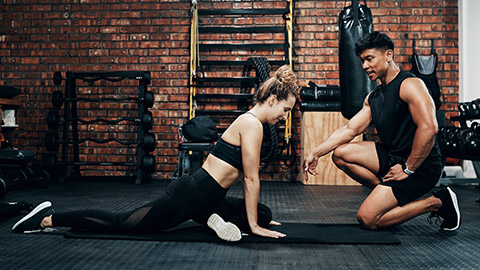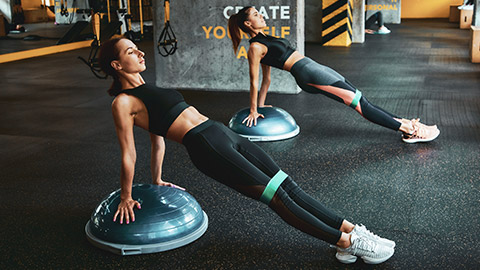Successful achievement of client goals will largely be determined by correct manipulation of resistance training variables. These variables include volume (sets and reps), intensity (load), tempo, rest intervals, and frequency.
The variables
A basic resistance programme should have at a minimum the following variables:
- Sets
- Reps
- Load
- Rest
You could also include:
- Tempo
- Intensity/RPE
Reps
A rep is one complete exercise movement. Training volume is prescribed according to the number of repetitions (or reps) per set. Reps can be classified into 3 approximate ranges:
- Low (1 – 5)
- Moderate (6 – 12)
- High (15 or more)
Low reps are optimal for increasing muscle strength, with minimal benefits to hypertrophy. Moderate reps are beneficial for hypertrophy. And high reps are best for achieving adaptations in muscular endurance.
Sets
A set is a group of consecutive repetitions of a specific exercise, with a rest interval in between sets. Using multiple sets over single sets maximises muscle strength and hypertrophy.
As a general guideline, there should be 2 – 4 sets per exercise.
Load
Load (or intensity) has the greatest influence on muscle hypertrophy and strength. It can be determined by repetition maximum (RM) - the maximum amount of weight lifted with correct technique for a given number of repetitions. E.g., 5RM is the max amount lifted with correct technique for 5 reps.
Intensities of 90-100% of 1RM are beneficial for goals related to muscular strength. 65-85% 1RM is optimal for muscular hypertrophy goals. Lower intensity of approximately 60% 1RM is sufficient for endurance-related goals.
Rest intervals
A rest interval is the length of time between the end of one set to the start of another set or exercise. Rest periods can have a significant influence on the adaptive response to resistance training and are largely related to intensity (load) applied.
Rest intervals can be classified into 3 approximate ranges:
- Short (30-60 seconds or less)
- Moderate (1 - 2 minutes)
- Long (3 minutes or more)
Short rest periods are best for training muscular endurance, where you want light loads at high repetitions.
Moderate rest periods are beneficial for hypertrophy training with moderate reps of moderate-to-heavy loads.
Long rest periods are beneficial for strength and power. Exercises are performed with heavy loads. Longer rest periods allow energy systems to be replenished (Cooke, n.d.).
Tempo
Tempo is the speed at which reps are performed and divided into 3 contractions:
- Eccentric (lowering)
- Isometric (static)
- Concentric (lifting)
Tempo is expressed in seconds, in 4 parts: eccentric – pause – concentric – pause. E.g., 3-1-2-1 means 3 second eccentric lowering, 1 second isometric hold in the bottom position, 2 second concentric raise, a second isometric hold in the top position.
Assigning variables
The following table summarises general guidelines for assigning volume and rest based on training goal.
| Training goal | Reps | Sets | Rest |
|---|---|---|---|
| Muscular endurance | 12+ | 1-2 | 30-60 seconds |
| Toning and shaping | 10-15 | 2-3 | 1 minute |
| Hypertrophy | 6-12 | 3-4 | 1-2 minutes |
| Muscular power | 6-8 | 3-4 | 3-5 minutes |
| Muscular strength | 1-6 | 3-5 | 3-5 minutes |
Recording variables
Any well-designed programme, once explained to a client, should be able to be picked up by anyone and performed safely. This means that each programme should be clear, well written, and leave no confusion about how and when to perform each movement.
If you are absent and another trainer is covering for you, they should be able to read and understand the programme easily. Clients will be expected to perform their programme on days without you, so they need to be able to understand what it says as well.
Including tips or notes can assist clients to remember key coaching points when you are not there.
The measure of your influence as a personal trainer is not how the client trains when they are with you – it’s how they train when you are not there.
Let’s look at the 2-day split programme we introduced in Exercise Selection. Note how all the essential information about variables is recorded, alongside coaching notes. This time, we’ve included the second day.
Jen 2-Day Split Training Programme
| Sunday | Monday | Tuesday | Wednesday | Thursday | Friday | Saturday |
|---|---|---|---|---|---|---|
| Yoga | Weights - lower | Bootcamp | Weights - upper | Bootcamp | Weights - lower | Long run |
Weights - lower
Warm-up: Cycle 15 Calories
Stretches: Dynamic Stretches (Lunge Hug, Side Squats, Walk the dog)
Activation: Glute Bridge with abduction x 10 reps
Potentiation: 10 reps of BB squat with just bar
| Exercise | Rest | Set 1 | Set 2 | Set 3 | Load | Notes |
|---|---|---|---|---|---|---|
| Barbell back squat | 90s | 10 35kg |
8 40kg |
6 45kg |
Hinge through hips | |
| Bulgarian split squat | 60s | 10 7kg |
10 7kg |
Drive through heels | ||
| Leg press | 10 83kg |
10 83kg |
Soft lock 15kg per side |
|||
| Dumbbell Romanian Dead Lift | 60s | 10 12kg |
10 12kg |
10 12kg |
Keep back flat | |
| Jump squats | 30s | 30s | 30s | 30s | As much height as possible | |
| Dead hang | 40s | 40s | Brace core, feet forward | |||
| Weighted plank | 40s 5kg |
40s 5kg |
Stay square |
Weights - Upper
Warm-up: Rower 500m
Stretches: Dynamic stretches (thread the needle, cat/cow, back pats)
| Exercise | Rest | Set 1 | Set 2 | Set 3 | Load | Notes |
|---|---|---|---|---|---|---|
| Barbell benchpress | 90s | 6-10 | 6-10 | 20kg | Full ROM | |
| Dumbbell flyes | 12 | 12 | 5kg | Big hug | ||
| Inverted row | 60s | 8 | 8 | Elbows close | ||
| Upright row | 8-10 | 8-10 | 15kg | Lead with elbows | ||
| Curl'n'press | 60s | 10 | 10 | 4kg | Twist through ROM | |
| Dumbbell kicks | 10 | 10 | 3kg | Elbows high | ||
| Medicine ball crunch | 60s | 10/10 | 10/10 | 3kg | Eyes on ceiling | |
| Medicine ball Russian twist | 10 | 10 | 3kg | 45 only | ||
| Medicine ball leg raises | 10 | 10 | 3kg | Shins to ball |
Programme Notes:
This programme is a progression from the full body programme you have been following. It will allow you to dedicate a bit more focus and energy to individual areas.
Ensure you stretch in between sets. Aim to increase the load as you get more accustomed to the movements.
We will change this programme in another 6-weeks' time.
Warm-up, cool-down, and stretches

The warm-up is an essential programme component. It helps reduce muscle soreness by ensuring muscles are well supplied with oxygen and reduces the risk of injury by elevating the heart rate and body temperature slowly to minimise the stress on the heart.
Low-intensity cardio exercises are a standard warm-up activity to help prepare the cardiovascular and respiratory systems for the upcoming activity. As discussed in Exercise Prescription A, after the cardio warm-up, it's important to do some activation and mobilisation work to ensure clients are fully ready to exercise
A post work-out cool-down is just as important as a warm-up. Once the main body of the workout (conditioning component) has been completed, the heart rate remains elevated, requiring time to return to resting. Abruptly ceasing exercise may create other issues including a build-up of lactic acid, which can lead to muscle cramping and stiffness or pooling of the blood in the veins leading to damage of their structural walls.
Implementing stretching within a programme is effective as it supports decreasing heart rate and stretching muscles, preparing them for rest and recovery. Depending upon the exercises selected and the client's training level, stretching may be performed in the warm-up or the cool-down session, or both.
Examples of cooling down practices may include:
- Low-intensity exercises
- Light body weight exercises including lunges and squats
- Foam rolling to increase blood flow and the breakdown of lactic acid and knots within the muscle
- Static stretching

For many people, committing to a training programme typically does not last long term. Boredom can kick in along with other demotivators and distractions which can lead to clients reducing then discontinuing their training. The important question each fitness professional should ask themselves, how can I ensure each training session is exciting and valuable to ensure the client continues working towards their goal?
Working with a personal trainer in itself can be a huge motivator for some people. However, other strategies should also be implemented within the training programme to support the client in remaining motivated and eager to progress. Some of these include:
- Ensure the training plan is realistic. The trainer will start off with light activity and gradually increase duration and intensity as the client progresses.
- Ensure the client enjoys the training exercises prepared for them. The personal trainer should tailor the training plan to suit them and what they enjoy, as well as encourage them to do exercises that work best to achieve their goals.
- Develop goals (both short and long term) that are achievable and realistic. As the client sees themselves achieving small goals, it will boost their motivation to continue.
- Enforce flexibility to cater to the client’s personal requirements. Everybody is different and their commitments may change from time to time, so being able to train at a time/location that is suitable to the client will encourage them to continue.
- No time-wasting! Minimise time-wasting and maximise results. Clients want to have effectively designed programmes that provide them with the right tools to maximise results.
- Develop a positive relationship with your client where they can feel comfortable discussing any concerns and struggles. Develop a plan that minimises the risk of injury.
- Do not overdo it. If a trainer develops a plan that consists of high intensity exercise 5 days a week, this can increase the risk of injury and become a demotivator. The training plan needs to consist of high intensity, low intensity, and stretching days to support the client’s rest and recovery.
Programme Monitoring and Re-evaluation
A health and fitness professional will typically write hundreds of programmes in their lifetime and perform just as many programme re-evaluations. Why? Self-improvement.
Guaranteed, any programme which has been well designed behind the scenes, ready and waiting for the client to walk in and begin their first session, will likely not run 100% to plan. This could be for a multitude of reasons that may include the following:
- The client is late
- The client is tired
- The client slept funny and has a sore neck/back
- The client didn’t sleep well due to stress and is feeling tired
- The machine you wish to use is taken by another member
- The client is feeling unwell
There are many other reasons which cannot always be controlled.
A large part of the trainer's role is to be prepared. To continue delivering amazing sessions to clients, it’s important to monitor and evaluate the programme and the services given to the client both during and after each session. An example of this may include, seeking verbal feedback from the client through these stages.
Before the session
Ask yourself:
- Is the prescribed programme at the correct level for the client?
- What will the plan be if someone is using the equipment required, what is the back-up plan?
During the session
Ask yourself:
- Is the client performing the exercises correctly? If the client is struggling it is the responsibility of the trainer to find an alternative way to communicate the requirements. For instance, adjusting language, visual demonstration and so on.
- Is my verbal delivery suitable for the client, do I need to rephrase my wording?
After the session
Ask yourself:
- Did the session run as planned, or did it require any programme adjustments?
- Did anything happen within the session which I was not expecting/prepared for?
- Did I have enough alternative exercises prepared to ensure the session remained smooth in the event of other people using the equipment which was required or the inability of the client to perform the planned exercise efficiently and safely?
- Was my verbal delivery correctly pitched for the client?
- Could my demonstrations be tweaked in future to better support clients?
- Was the programme clear? Did the client understand what exercises were to be performed and how to perform them?
- Was there adequate time to get through the programme?
Self-evaluation versus client feedback
Programme monitoring and re-evaluation can and should be performed through self-evaluation and client feedback. Self-evaluation is not commonly practised within the industry. Why would an awesome program need to be self-evaluated? For the reasons above, that is why! Any professional trainer worth their salt would want to continuously improve by reflecting on what they can control within a session.
Another extremely effective way to ensure a smooth session and programme design is to seek feedback from the client. This can be obtained by watching them perform the exercises and gauging their RPE and listening to their verbal feedback. It can also be further obtained by asking them after the session what they felt worked well and what they felt could work better. There is no pride lost in asking for feedback. In fact, both trust and respect are gained by asking for further information to ensure they have a safe and effective experience. This type of professional conduct will be what sets you above the rest.

